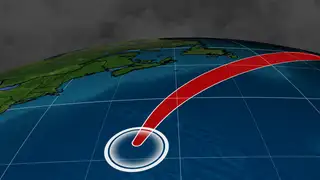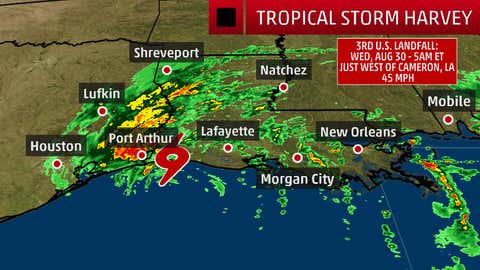Historic Hurricane Harvey's Recap | The Weather Channel (original) (raw)

Play
- Harvey was a catastrophic flood disaster in southeast Texas.
- Harvey made landfall as a Category 4 Hurricane with winds of 130 mph near Rockport, Texas.
- Harvey meandered around southern Texas for days as a weakening hurricane and tropical storm.
- As a tropical storm, Harvey dropped 40-61 inches of rainfall in southeast Texas and southwest Louisiana.
- All-time U.S. tropical cyclone rain records were broken.
- Harvey triggered flash flooding in parts of Arkansas, Kentucky, and Tennessee from Aug. 31-Sept. 1.
Harvey's long-lived odyssey has come to an end but its catastrophic impacts will be felt for weeks and months to come.
Harvey's Recap: A Truly Historic Hurricane
Below is a comprehensive look back at the history of Harvey, beginning with an overview of its journey, followed by recaps of its landfall impacts and catastrophic flooding.
Overview
Harvey roots can be traced back to a tropical wave that emerged from the African coast in early August.
That disturbance finally formed into Tropical Storm Harvey east of the Lesser Antilles on Aug. 17. Those islands experienced locally heavy rain and gusty winds as Harvey passed through.
A couple of days later, Harvey succumbed to dry air and unfavorable winds aloft in the eastern Caribbean, and the National Hurricane Center ceased advisories on Aug. 19.

The remnants of Harvey continued to push northwest for several days and eventually crossed Mexico's Yucatan Peninsula. Once its remnants moved back over water in the southwest Gulf of Mexico, Harvey quickly reformed into a tropical depression on Aug. 23.
In just 56 hours, Harvey grew from a regenerated tropical depression over the Gulf of Mexico into a Category 4 hurricane as it made landfall near the Texas Gulf Coast late on Aug. 25.
(MORE: Why Harvey Rapidly Intensified)
Harvey's center of circulation stalled over south Texas on Aug. 26 and then meandered slowly east into the Gulf of Mexico before making a final landfall near Cameron, Louisiana, on Aug. 30.
Still a named storm 117 hours after landfall, Harvey was the longest a Texas landfalling hurricane remained a named storm after landfall on record, according to Colorado State University tropical scientist Dr. Phil Klotzbach.
It was the slow movement from Aug. 26-30 that led to the catastrophic flooding that was observed in southeast Texas.
It is very unlikely that we will see the name "Harvey" used again for another tropical cyclone due to its extreme damage and devastation along the Gulf Coast.
Harvey's Category 4 Landfall
Harvey made landfall on the evening of Aug. 25 near Rockport, a town of less than 10,000 people and about 30 miles up the Texas coast from Corpus Christi. Maximum sustained winds in Harvey's eyewall were 130 mph at that time, making it a Category 4.
Harvey was the nation's first major (Category 3 or stronger) hurricane landfall since Hurricane Wilma struck South Florida in October 2005, an almost 12-year run.

Wind gusts from Harvey near its landfall point topped 100 mph in many locations, leading to widespread destruction of homes and buildings.
Top Wind Gust Reports
- Port Aransas: 132 mph, sustained to 110 mph
- Near Copano Village: 125 mph
- Near Lamar: 110 mph
- Rockport: 108 mph
- Near Taft: 90 mph
- Near Magnolia Beach: 79 mph
- Palacios: 69 mph
- Corpus Christi Int'l Airport: 63 mph
- Austin Bergstrom Int'l Airport: 52 mph
Pounding waves on top of Harvey's storm surge also inundated parts of the Texas Coastal Bend, resulting in damage in some areas.
The maximum observed water level rise at Harvey's landfall point was 6.71 feet at Port Lavaca.
Harvey was the strongest landfall in this area, known as the Texas Coastal Bend, since Hurricane Carla, in September 1961.
To see a complete radar loop of Harvey from landfall until the end of its lifespan, Brian McNoldy at the University of Miami, Rosenstiel School, has put together an incredible seven-day radar loop that you can see here.
The only other Category 4 landfall of record near the Texas Coastal Bend was the infamous Indianola hurricane of August 1886, which devastated the town of Indianola just 11 years after another Category 3 hurricane, eventually turning the former bustling port into a ghost town.
Catastrophic, Record Flooding in Southeast Texas
Harvey's extreme slow movement Aug. 26-30 kept a fire hose of moisture pointed into southeast Texas and Louisiana for days, resulting in catastrophic flooding.
Numerous flash flood emergencies were issued for the Houston and Beaumont, Texas, metropolitan areas, and for Bastrop County and nearby communities.
The areal coverage of locations picking up at least 20 inches of rain was greater than the state of West Virginia, while the 40-inch-plus zone was larger than Delaware.
The top rainfall total is 60.58 inches in Nederland, Texas from Aug. 24-Sep. 1. Incredibly, a second site, Groves, Texas, also topped the record book by receiving more than 60 inches during that same time period. Both of these topped the previous tropical cyclone rainfall record.
Pending final confirmation, this rainfall total would be the heaviest from any tropical cyclone in the U.S. in records dating to 1950, topping the 48-inch storm total in Medina, Texas, from Tropical Storm Amelia in 1978, according to research by NOAA/WPC meteorologist David Roth.
Top Rainfall Reports
- 60.58 inches near Nederland, Texas
- 60.54 inches in Groves, Texas
- 56.00 inches in Friendswood, Texas
- 54.77 inches near Santa Fe, Texas
- 54.00 inches near Bunker Hill Village, Texas
- 52.87 inches on Clear Creek at Interstate 45 near League City, Texas
- 49.31 inches near Dayton
- 49.20 inches on Mary's Creek at Winding Road
- 49.06 inches near Beaumont, Texas
- 45.74 inches near Pasadena
- 44.91 inches near South Houston
- 43.38 inches at the NWS forecast office in Houston (League City)
- 37.01 inches at Houston Hobby Airport
- 35.87 inches near Sabine Pass, Texas
- 31.26 inches at Houston Bush Intercontinental Airport
- 28.14 inches in northeast Galveston
- 21.88 inches in Smithville
- 19.64 inches in College Station
- 17.28 inches near Lake Charles, Louisiana
- 15.60 inches near Victoria
- 9.96 inches near Watson, Arkansas
- 9.12 inches near New Iberia, Louisiana
- 8.27 inches near Gautier, Mississippi
- 7.95 inches at Pensacola Regional Airport, Florida
- 6.68 inches near Alexandria, Louisana
- 5.73 inches near Plano, Kentucky
Please note that a previous report of 51.88 inches on Cedar Bayou near Highlands, Texas has been taken off the books by NWS Houston due to this gauge and several others being flooded or being impacted by high winds, which hinder the capability of gauges capturing the true rainfall amounts.
Houston's Bush Intercontinental Airport crushed its record-wettest calendar day Sunday by over 5 inches, picking up 16.07 inches of rain, just under the five-day total of 16.48 inches from Tropical Storm Allison in 2001. Houston's Hobby Airport also crushed a two-day rainfall record by almost 8 inches, picking up 23.06 inches of rain Aug. 26-27.
Houston had two of its five heaviest calendar-day rainfalls from Harvey.
The average rainfall within the Harris County Emergency Management network exceeded that of Tropical Storm Allison (2001) in almost half of the time (2 to 3 days versus 5 days). The Harris County Flood Control District estimated one trillion gallons of water was dumped on the county alone in four days.
Harvey's flooding has caused one of the worst weather disasters in U.S. history, with a price tag that will amount to billions of dollars. The HCFCD estimated 70 percent of Harris County was flooded by at least 1.5 feet of water, with an estimated 136,000 flooded structures in the county alone, as of August 31.
Thousands of water rescues occurred in the Houston metro area as many homes and businesses were swamped by floodwaters.
Houston wasn't the only location to suffer disastrous flooding.
Jack Brooks Regional Airport near Port Arthur, Texas, picked up a staggering 26.03 inches of rain on Aug. 29 alone, more than doubling the previous calendar-day rainfall record in Beaumont-Port Arthur set over 94 years ago. Its storm total from Aug. 26-30 was an incredible 47.35 inches of rain, almost 25 inches greater than its previous record four-day rain record set in September 1980.
The resultant flooding swamped a storm shelter in Port Arthur, prompting evacuees to be moved to another shelter.
Interstate 10 between Beaumont and Winnie, Texas, was overtaken by the floodwaters, as well.
Serious flooding also occurred southwest of Houston along the Brazos, Colorado and Guadalupe Rivers.
In total, 19 National Weather Service river gauges had observed record flooding as of Aug. 31.
This wasn't just a story in Texas and Louisiana, either. According to hurricane researcher Brenden Moses, Harvey was among the wettest tropical cyclones on record in Kentucky, Tennessee and Arkansas.

Harvey's final landfall in southern Louisiana near the Texas border.
Harvey has also spawned numerous brief tornadoes in southeast Texas, Louisiana, Alabama, Mississippi, Tennessee and North Carolina. Harvey is one of the most prolific tornado producers for a tropical cyclone, but the true number of tornadoes produced by Harvey may never be known. Many tornadoes tracked near or through floodwaters and many may have crossed paths.
In the southwest suburb of Missouri City, more than 50 homes were damaged in the Sienna Plantation neighborhood.
One EF2 was reported near Evangeline, Louisiana during Harvey, which is the strongest known tornado during that hurricane. The tornado traveled for more than 2 miles damaging 4 homes, a truck, numerous trees and a few power poles. One home lost the majority of its roof and had exterior wall failure.
On Aug. 31 into the early morning of Sept. 1, significant flash flooding was reported in parts of Arkansas, Kentucky, Mississippi and Tennessee, including the Nashville metro area. About 30 water rescues were performed in Davidson County, Tennessee. Evacuations were needed along Whites Creek, Browns Creek, Mill Creek and Seven-Mile Creek in the Nashville metro.
Numerous roads were closed and county schools were closed Friday in Simpson County, Kentucky.

Marine Corps League member Jeff Webb, left, of Montgomery, Texas, and rescue diver Stephan Bradshaw, right, of South Carolina rescue a dog that was chained to a flooded porch as a result of Tropical Storm Harvey Thursday, Aug. 31, 2017 in Lumberton, Texas. (Ashley Landis/The Dallas Morning News via AP)